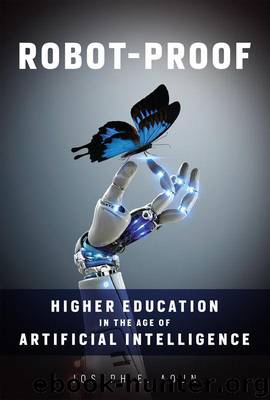Robot-Proof: Higher Education in the Age of Artificial Intelligence (MIT Press) by Joseph E. Aoun

Author:Joseph E. Aoun
Language: eng
Format: azw3, epub
Tags: educational, lifelong learning, AI, literacies, university, robotics, experiential learning, automation, students, future, college, human, teaching, technology, machines, literacy
Publisher: The MIT Press
Published: 2017-08-17T22:00:00+00:00
4
The Experiential Difference
In 2011, IBM’s supercomputer, Watson, became the first machine ever to compete on the game show Jeopardy! Its opponents were the two greatest human champions in the game’s history—Ken Jennings, who held the record for the longest winning streak, and Brad Rutter, who was the show’s biggest all-time money winner. But although Watson soundly defeated his biological competitors, it did not play an entirely flawless game.
In one clue, host Alex Trebek said, “It was the anatomical oddity of U.S. gymnast George Eyser, who won a gold medal on the parallel bars in 1904.” Jennings incorrectly answered that Eyser was missing an arm. Watson then chimed in, “What is a leg?” Although it guessed the body part correctly, it failed to note that the limb was, in fact, missing. David Ferrucci, who led the Watson project, observed that the computer had probably tripped up on the word “oddity.” It would not have known, he said, that a missing leg is necessarily odd.1
Its biggest mistake, however, occurred in the final round of day 2. Under the “U.S. Cities” category, the clue read: “Its largest airport was named for a World War II hero; its second-largest, for a World War II battle.” Both of the human beings correctly answered, “What is Chicago?” But Watson had been programmed to focus on the precise wording of the clue, giving less weight to the category title. Because “U.S. city” never appeared in the phrasing, it incorrectly guessed, “What is Toronto???”
Despite this hiccup, Watson handily routed the humans, and in the aftermath Jennings published an essay in Slate describing his defeat. “Just as factory jobs were eliminated in the 20th century by new assembly-line robots,” he wrote, “Brad and I were the first knowledge-industry workers put out of work by the new generation of ‘thinking’ machines. ‘Quiz show contestant’ may be the first job made redundant by Watson, but I’m sure it won’t be the last.”2
Jennings was certainly correct, but a more intriguing observation came during a moment of consolation. One of the IBM engineers told Jennings that his streak of game show victories had helped inspire the Watson project. “We looked at your games over and over, your style of play,” the engineer said. “There’s a lot of you in Watson.”
Machine learning, as the engineer’s comments suggest, is similar to human learning in some ways and very different in others. Computers such as Watson improve by casting their nets across inputs, trawling through them for patterns. The computer picks the “correct” answer based on the broadest consensus of its data sets. In many ways, it is a display of informational crowdsourcing. In Watson’s case, some of those inputs included Jennings’ play style and strategies.
Intelligent machines get better through exposure to wider and wider pools of information. At a certain point, this learning technique is not unavailable to us because human brains cannot possibly absorb data at such a scale. But human brains have their advantages, too.
The human Jeopardy! players erred through lack of knowledge, sluggish reflexes, nerves, or perhaps simply a hiccup of the synapses.
Download
Robot-Proof: Higher Education in the Age of Artificial Intelligence (MIT Press) by Joseph E. Aoun.epub
This site does not store any files on its server. We only index and link to content provided by other sites. Please contact the content providers to delete copyright contents if any and email us, we'll remove relevant links or contents immediately.
Whiskies Galore by Ian Buxton(41941)
Introduction to Aircraft Design (Cambridge Aerospace Series) by John P. Fielding(33095)
Small Unmanned Fixed-wing Aircraft Design by Andrew J. Keane Andras Sobester James P. Scanlan & András Sóbester & James P. Scanlan(32767)
Craft Beer for the Homebrewer by Michael Agnew(18200)
Turbulence by E. J. Noyes(7983)
The Complete Stick Figure Physics Tutorials by Allen Sarah(7339)
Kaplan MCAT General Chemistry Review by Kaplan(6903)
The Thirst by Nesbo Jo(6882)
Bad Blood by John Carreyrou(6584)
Modelling of Convective Heat and Mass Transfer in Rotating Flows by Igor V. Shevchuk(6408)
Learning SQL by Alan Beaulieu(6239)
Weapons of Math Destruction by Cathy O'Neil(6220)
Man-made Catastrophes and Risk Information Concealment by Dmitry Chernov & Didier Sornette(5958)
Digital Minimalism by Cal Newport;(5707)
Life 3.0: Being Human in the Age of Artificial Intelligence by Tegmark Max(5519)
iGen by Jean M. Twenge(5387)
Secrets of Antigravity Propulsion: Tesla, UFOs, and Classified Aerospace Technology by Ph.D. Paul A. Laviolette(5336)
Design of Trajectory Optimization Approach for Space Maneuver Vehicle Skip Entry Problems by Runqi Chai & Al Savvaris & Antonios Tsourdos & Senchun Chai(5040)
Pale Blue Dot by Carl Sagan(4960)
